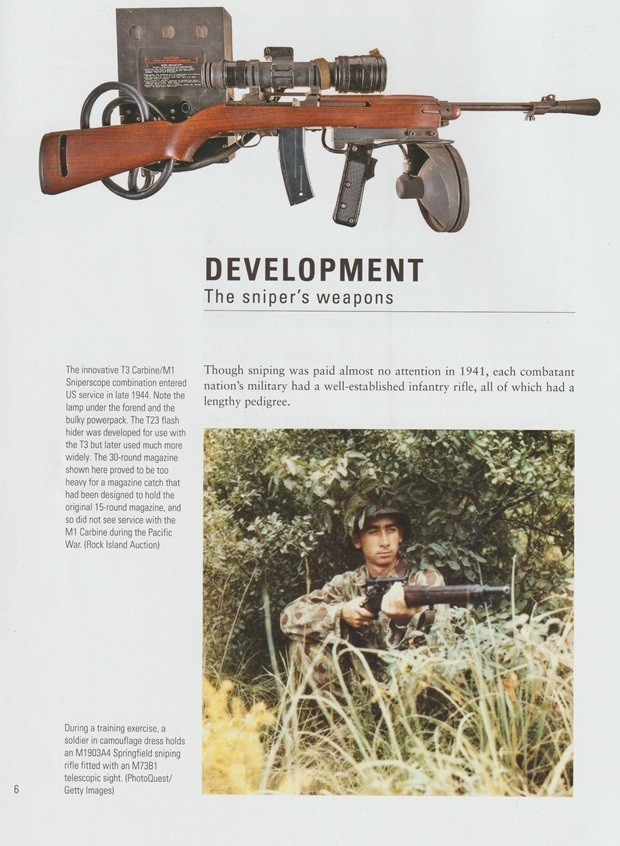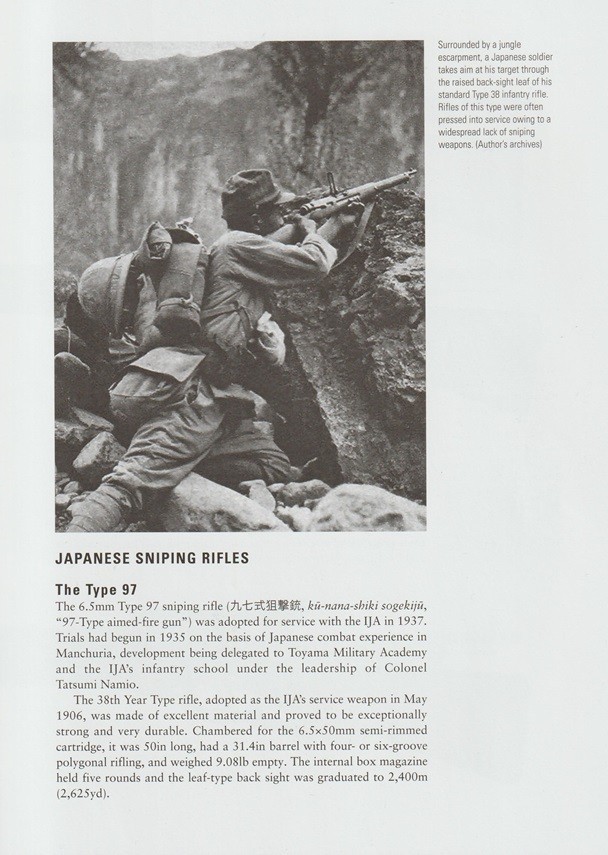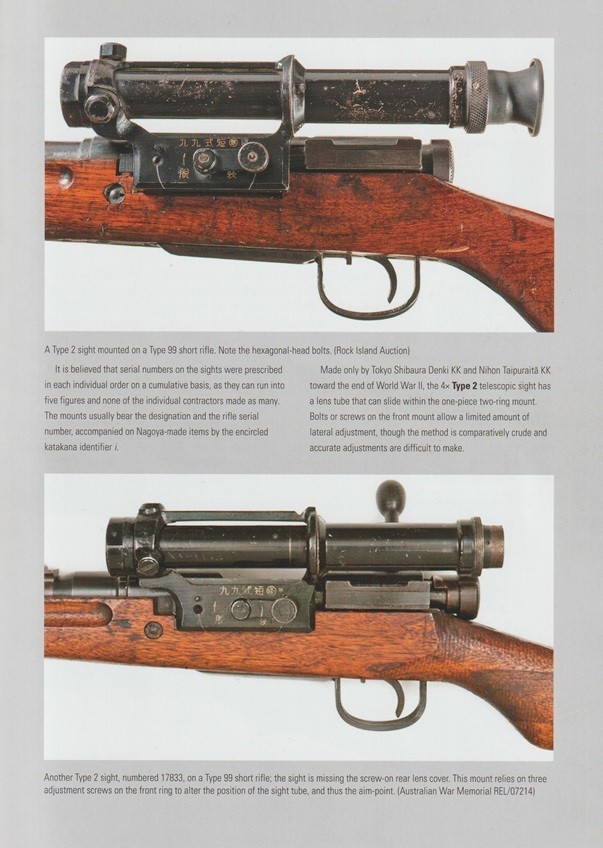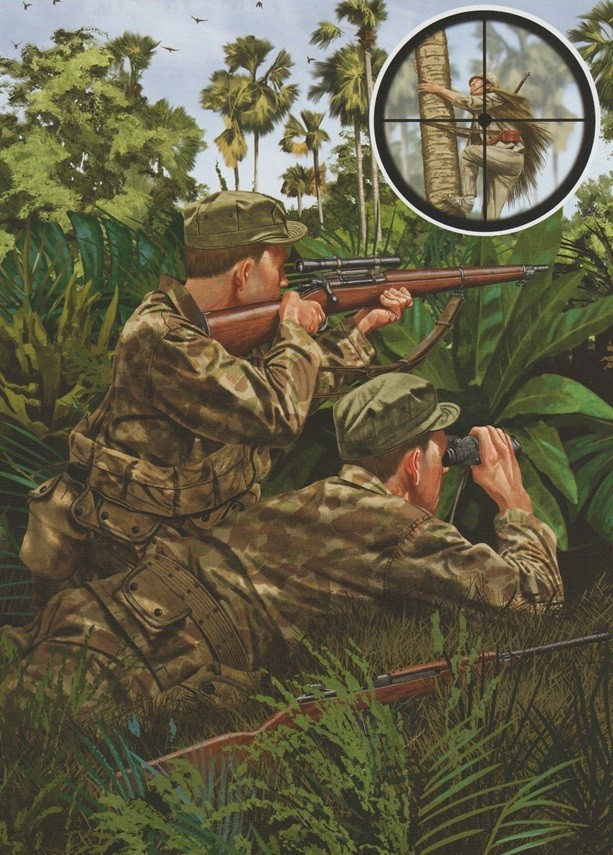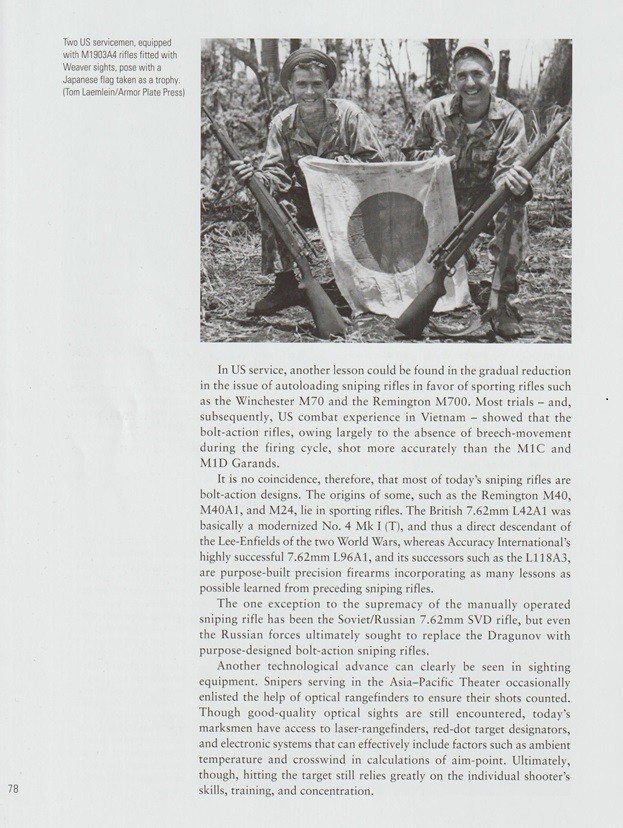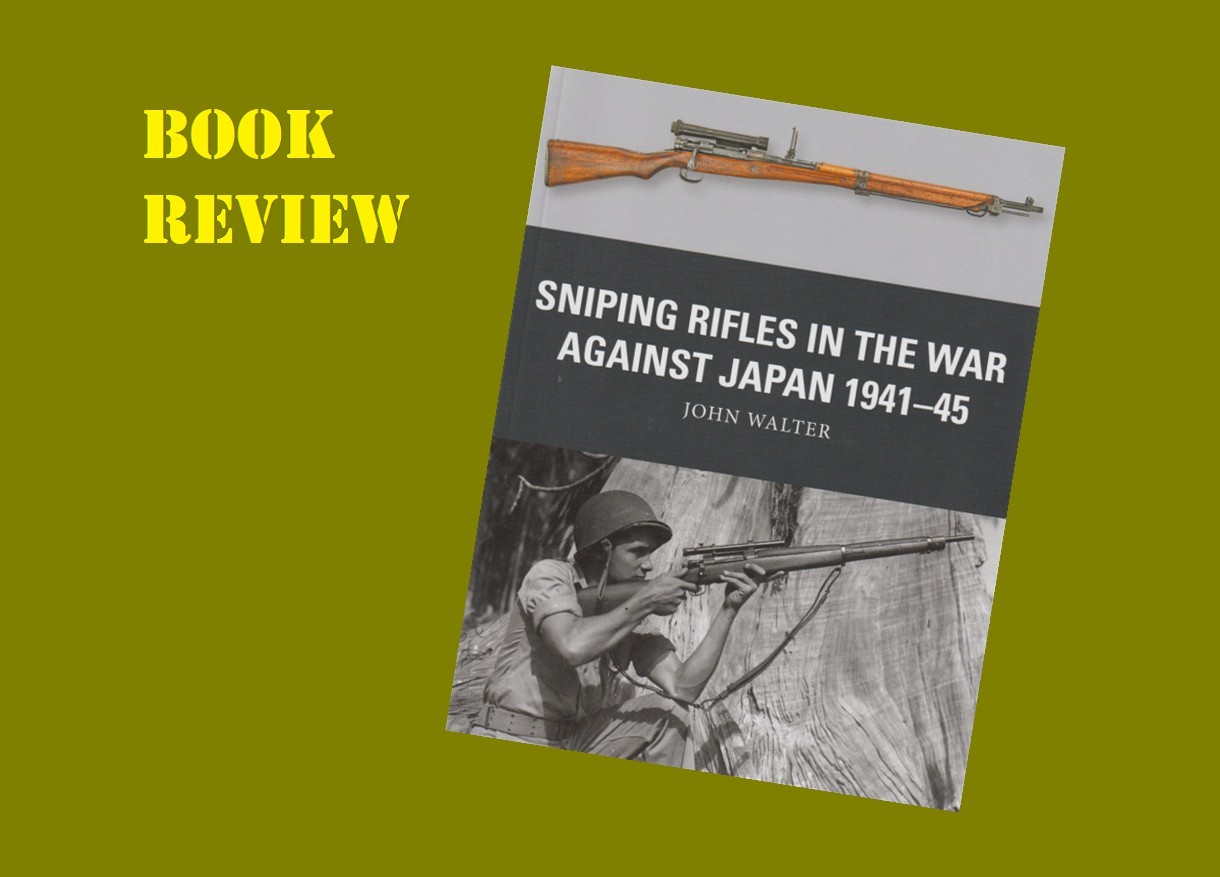HISTORY:
** During World War II, both the Japanese and their Allied opponents made extensive use of snipers armed with a miscellany of rifles, scopes and accessories. These troops were prepared by widely differing levels of training and tactical doctrine. The challenges of fighting in a variety of harsh environments, from the Pacific islands to the vast expanses of China, prompted improvisation and innovation on both sides in the ongoing war between snipers and their adversaries. Often operating at relatively close ranges in restrictive terrain, snipers made particularly ingenious use of camouflage and deception as the fighting spread across Asia and the Pacific in the wake of the Pearl Harbor attack, while troops tasked with countering enemy marksmen had to learn the hard way how best to defeat a seemingly invisible enemy.
Small arms expert John Walter considers the strengths and limitations of the weapons and specialist equipment deployed by Japanese snipers and their Allied counterparts, as well as their different approaches to sniping tactics and training. Specially commissioned artwork and carefully chosen photographs illustrate this enthralling study of the sniping war in Asia and the Pacific during World War II. **
** Quoted from the back cover of the book.
THE BOOK:
Osprey Publications has released Sniping Rifles in the War Against Japan 1941-45 as Number 88 in the Weapon series. It is an 80-page soft cover book. Included with the text are black and white and color photographs, color illustrations, detailed captions, cutaway views and more. It has a 2024 copyright, a publication date of February 15, 2024, and the ISBN is 978-1-4728- 5832-0.
THE CONTENTS:
- Introduction
- Development
- The sniper’s weapons
- Use
- Snipers in combat
- Impact
- Snipers on the battlefield
- Conclusion
- Bibliography
- Index
THE TEXT:
Author John Walter provides a well written text detailing the various sniping rifles used by the allied militaries and the Japanese military during World War II throughout the years of 1941 through 1945. Walter provides information such as caliber, numbers produced, branches of the military they were issues to, locations where they were used their effectiveness and accuracy, faults and advantages and other such information on the Japanese Type 97 rifle, Japanese Type 99 rifle, British and Commonwealth P14 Mk I* (T) rifle, British and Commonwealth No. 4 Mk I (T) rifle, British and Commonwealth No. 1 Mk III (HT) rifle, United States M1903A4 Springfield rifle, United States Winchester Model 70 rifle, United States M1C Garand rifle, United States M1941 Johnson rifle, as well as the United States M1 and M2 Carbines. As well as providing information on the various rifles Walter also provides information on the various types and models of telescopic sights that were fitted to the rifles so they could be used in the sniper rifle role as well as the types of ammunition used. In addition to detailing the various weapons used, Walter also provides information on the different countries response to the need of having snipers on the battlefield, the training that they went through, and the decisions made as to where to deploy the snipers. The training put into practice for the Japanese, American and British and Commonwealth snipers is also discussed. Walter also provides information on how it was discovered that having bayonets attached to the rifles would affect the weapons performance on rifles such as the Japanese Type 97, Japanese Type 99, Russian Mosin-Nagant, and the United States M1 Garand rifles. Walters also discusses the effectiveness of the different countries’ snipers and their impact on the battlefield as well as how the snipers were dealt with by the opposing forces. John Walter provides an excellent description of all the technical specifications of the weapons and their accessories in an easy-to-read format which detail oriented readers will benefit from. I personally feel that John Walter has covered all areas and aspects of the specific weapons and left no area of the weapons undiscussed in detail. As I read through the text, I didn't notice any spelling or grammatical errors. Grammar and spelling might not be an important factor to everyone however it is something that I take notice of and pass on my findings. I feel that if the text is well written then it shows that the author has taken the time to be professional with their writing.
THE PHOTOGRAPHS:
A total of 25 black and white photographs and 46 color photographs are included in this volume. The photographs are for the most part close-up detailed photographs of the various rifles and accessories that are clear and easily viewable. The majority of the photographs are of just the weapons and accessories themselves as opposed to photographs that feature the weapons in a broad generalized military photograph that lack focus on the specific weapon and associated equipment, which in my opinion it makes it much easier to study the various weapons and their details such as the manufactures markings. The photographs also include subjects such as telescopic sights, optical device carrying cases, telescopic sight mounting plates and devices, cheekpieces, rifle slings, ammunition, ammunition clips and chargers, No. 4 Mk 1 wooden transit case, and more. As well as showing the various weapons and their accessories, the photographs also provide excellent details such as the various uniforms being worn. The majority of the photographs are clear and easily viewable; however, a few of the black and white period photographs appear to be too dark, while others appear to be too light. This can be typical for the discussed period of history and the quality of the photographs is of no fault of the author and they do not take anything away from the book. Author John Walter stuck to the title of the book and chose subject specific photographs and did not include photographs that strayed from the main subject of the book. The majority, if not all of the photographs, will prove to be a wealth of information to anyone interested in sniping rifles and their accessories used by the allied militaries and the Japanese military during World War II due to the details that they contain.
THE ILLUSTRATIONS:
There are 6 color illustrations with detailed captions included by illustrators Johnny Shumate and Alan Gilliland. The illustrations are very well done, nicely detailed and are of:
Plate A
Commanding the jungle, Burma, 1944
– A two-page color action illustration depicting a Japanese sniper armed with a 6.5mm Type 97 with a 2.5x Type 97 optical sight taking aim at a British junior officer that is armed with a U.S. made .30 M1 Carbine. The illustration features an inset illustration showing the sniper’s view through the telescopic sight.
Plate B
Sniper vs sniper, the Pacific, 1945 (see attached scan)
- A one-page color action illustration depicting a US sniper team preparing to engage a Japanese sniper. The US sniper, armed with a .30-caliber M1903A4 Springfield rifle with a M73B1 optical sight is taking aim and his spotter, with his US M1 carbine on the ground next to him, is using binoculars to watch the enemy sniper. The US sniper team are both wearing camouflage uniforms. The illustration features an inset illustration showing the sniper’s view through the telescopic sight.
Cut-A-Way Illustrations
Plate A
The Type 97 Exposed
- A two-page color cut-a-away view showing the internal workings of the Japanese 6.5mm Arisaka Type 97 sniping rifle Also provided is a key which details 32 specific items that are pointed out on the weapon.
Plate B
The Heavy-Barrel SMLE Revealed
- A two-page color cut-a-away view showing the internal workings of the British .303 SMLE No. 1 Mk III* (HT) rifle with P1918 sight. Also provided is a key which details 31 specific items that are pointed out on the weapon.
Plate C
The M1903A4 Unveiled
- A two-page color cut-a-away view showing the internal workings of the U.S. .30-06 M1903A4 rifle with Weaver 330C sight. Also provided is a key which details 28 specific items that are pointed out on the weapon.
Plate D
The Winchester Model 70 Revealed
- A two-page color cut-a-away view showing the internal workings of the U.S. .30-06 Winchester Model 70 with Unertl sight. Also provided is a key which details 24 specific items that are pointed out on the weapon.
THE CAPTIONS:
The captions are well written and explain the accompanying photographs and illustrations in great detail eliminating any doubt as to what is shown. The captions go into very specific detail as to the specific weapons shown and their caliber, manufacturers markings, names of specific individuals and their military rank, military units, associated equipment carried and used and other such specific items of interest, dates and locations and other such pertinent information. As I read through the captions, I didn’t notice any spelling or grammatical errors. John Walter’s captions will be helpful to the reader due to their detailed content as opposed to other captions that I have seen that are very brief and lacking in detail.
CONCLUSION:
As with the other Osprey Publishing titles I was impressed with this book. This is a very nice reference book that contains a well written informative text, many subject specific photographs and illustrations, well detailed captions and more, all detailing sniping rifles used by the allied militaries and the Japanese military during World War II throughout the years of 1941 through 1945. As with the other Osprey Publishing titles, I would have no hesitation in recommending this book to others as it will be a welcome addition to one’s personal reference library.
Osprey Publishing also offers Sniping Rifles in the War Against Japan 1941-45 as:
eBook (PDF) ISBN: 978-1-4728- 5830-6
and
Ebook (Epub & Mobi) ISBN: 978-1-4728- 5833-7
Osprey Publishing’s, Sniping Rifles in the War Against Japan 1941-45 is also available as an electronic Kindle version through Amazon.com.
PRICE:
US $23.00 / UK £15.99 / CAN $31.00
This book was provided to me by Osprey Publishing. Please mention that you saw the book reviewed here on the KitMaker Network when you make your purchase. Thank you.

